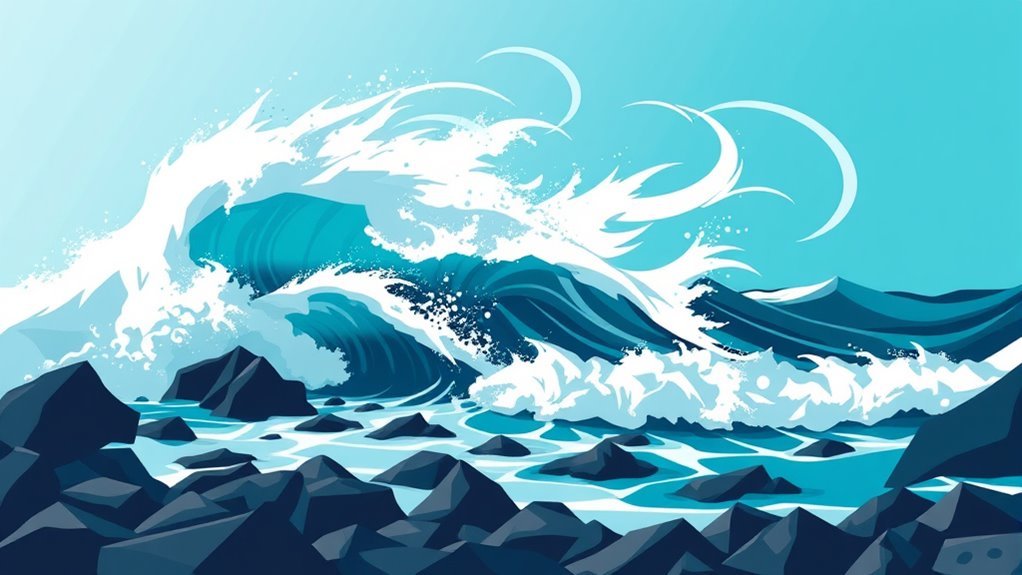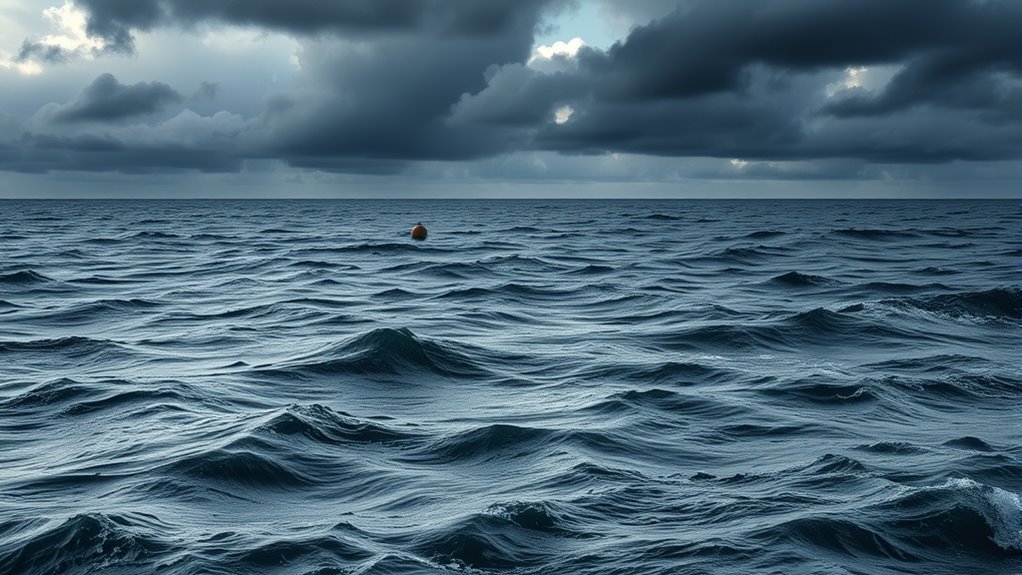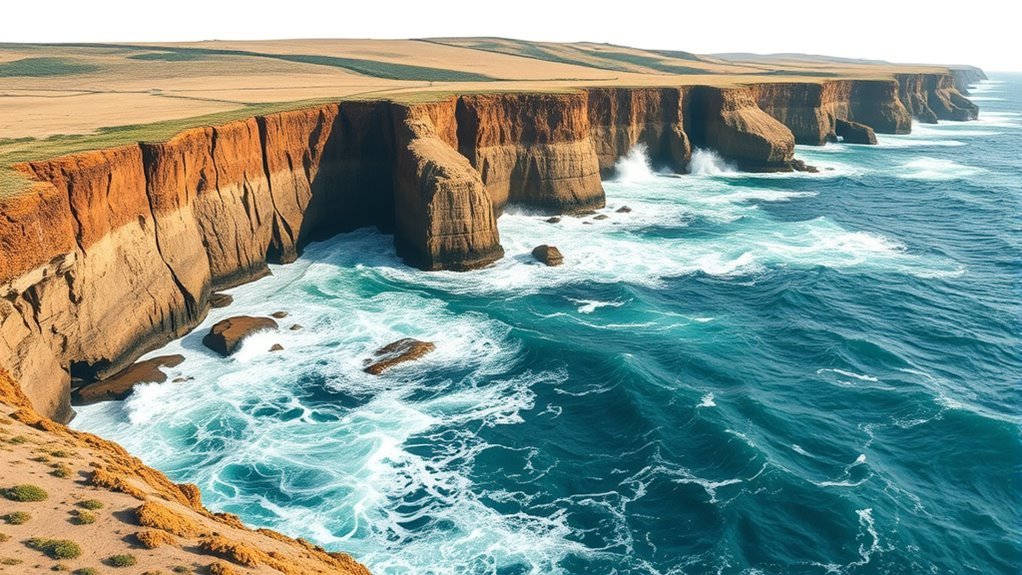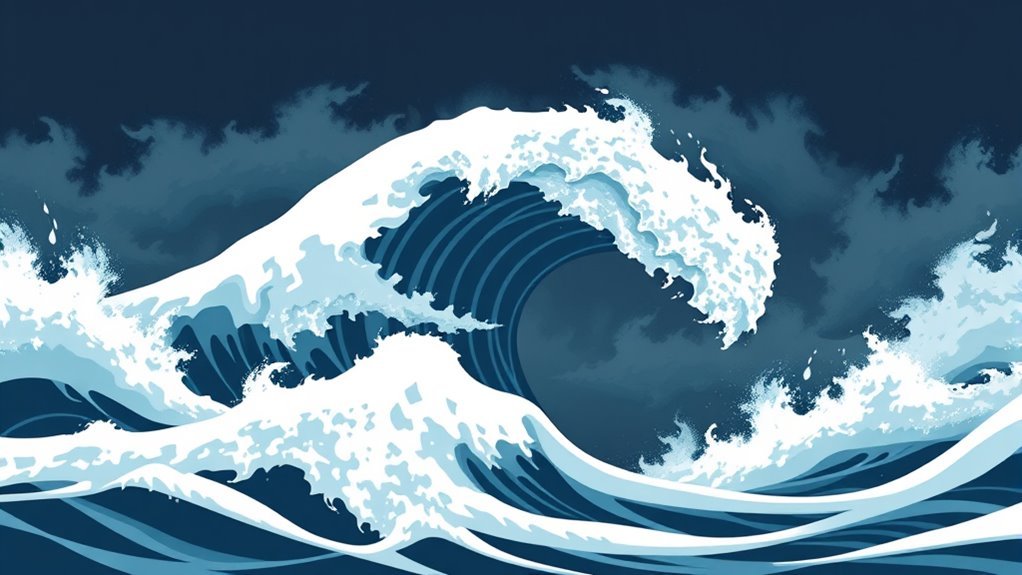Squalls rapidly increase wave height and alter wave behavior in open waters. They create steep, choppy waves due to sudden wind shifts and intensified wind speeds, often exceeding 30 knots. This intense wind energy transfers to the water surface, leading to turbulent flow patterns and strong currents. Abrupt changes in wind direction also complicate navigation and increase the risk of capsizing. Understanding these dynamics is essential for anyone venturing into affected areas, and further perspectives await those interested.
Main Points
- Squalls cause rapid increases in wind speed, leading to steep and choppy wave patterns in open waters.
- Intense wind shifts during squalls create abrupt changes in wave height, increasing the risk of capsizing vessels.
- Energy transfer from squalls alters wave behavior, resulting in turbulent flow patterns and stronger surface currents.
- Sudden changes in wind direction during squalls complicate navigation by disrupting existing water current behavior.
- The interaction of surface and subsurface currents during squalls creates complex dynamics that challenge mariners in open waters.
Understanding Squalls: Definition and Characteristics
Squalls are sudden, intense weather disturbances defined by a rapid increase in wind speed and often accompanied by heavy rain. These phenomena typically occur in localized areas, manifesting without much warning, which can create hazardous conditions for marine activities.
Characteristically, squalls feature a sharp increase in wind intensity, frequently exceeding 30 knots, and can last from a few minutes to several hours. The shift from calm to turbulent winds can lead to notable changes in wave patterns, causing steep, choppy waves that pose risks to vessels.
The precipitation associated with squalls can further reduce visibility and complicate navigation. Understanding these characteristics is essential for sailors, fishermen, and coastal residents, as squalls can dramatically alter water conditions and safety in a short period.
Preparedness and awareness are important to mitigate the potential dangers posed by these unpredictable weather events.
The Relationship Between Squalls and Wind Patterns

While often sudden and localized, squalls are complexly linked to prevailing wind patterns. These intense bursts of wind typically arise from localized atmospheric disturbances, which interact dynamically with existing wind currents. As squalls develop, they can disrupt or improve the prevailing winds, leading to rapid changes in wind direction and speed.
This relationship is particularly evident in coastal regions where land and sea breezes can create conditions conducive to squall formation. Additionally, squalls may originate from larger weather systems, such as cold fronts, that alter the general wind patterns over extensive areas.
The interplay between squalls and wind patterns can create varying conditions for mariners and researchers alike. Understanding these connections is essential, as they can influence navigation, safety, and the behavior of water currents.
In the end, the relationship between squalls and wind patterns is a critical aspect of oceanographic studies and weather forecasting.
Impact of Squalls on Wave Height and Behavior
Squalls greatly influence wave dynamics, particularly regarding wave height and direction.
As squalls intensify, they can lead to a pronounced increase in wave height, creating hazardous conditions for navigation and marine activities.
Additionally, the abrupt shifts in wind direction associated with squalls can alter the typical wave patterns, resulting in unpredictable wave behavior.
Wave Height Increase
Intense weather events considerably influence wave dynamics, leading to notable increases in wave height.
Squalls, defined by sudden and intense wind changes, generate energy that greatly impacts the surface of open waters. As wind speeds surge, they create friction with the water, resulting in the formation of larger waves.
The intensity and duration of these squalls determine the extent of the height increase; more prolonged events can lead to towering swells that pose risks to vessels and coastal structures.
The turbulent conditions also disrupt the equilibrium of existing wave systems, causing chaotic interactions among waves.
Consequently, understanding how squalls affect wave height is essential for navigation safety and predicting potential hazards in marine environments.
Wave Direction Changes
How do squalls influence the direction of waves in addition to their height?
Squalls, defined by sudden increases in wind speed and changes in atmospheric pressure, can greatly alter wave direction. As the wind shifts rapidly, it generates waves that may propagate at angles different from the prevailing conditions.
This change occurs because the energy transfer from the wind to the water surface is affected by the squall's intensity and direction. Consequently, waves may not only increase in height but also become steep and chaotic, leading to unpredictable patterns.
These alterations in wave direction can impact navigation, fishing activities, and marine ecosystems, highlighting the importance of understanding squalls in open waters.
How Squalls Generate Surface and Subsurface Currents

Squalls influence both surface and subsurface currents through variations in wind speed and direction.
This variability creates shear layers that disrupt the water column, leading to complex current patterns.
Additionally, the pressure gradients established during a squall can further improve the movement of water, contributing to dynamic oceanic conditions.
Wind Speed Variability
Wind speed variability plays an essential role in generating both surface and subsurface currents during squalls.
As wind speeds fluctuate, they exert varying forces on the water's surface, leading to the development of turbulent flow patterns. These patterns can create noteworthy differences in water movement, resulting in stronger surface currents in areas where winds intensify.
Conversely, reduced wind speeds can allow for the establishment of calmer conditions, which can affect how subsurface currents are formed and maintained.
The interaction between these surface and subsurface currents is critical, as the energy from the wind not only drives the immediate water motion but also influences deeper layers, creating complex dynamics in open waters.
Understanding this variability is fundamental for predicting squall impacts.
Shear Layer Formation
As squalls intensify, they create distinct shear layers in the water column, resulting from the differential movement between surface and subsurface currents. This phenomenon leads to the generation of complex flow patterns, often defined by notable velocity gradients.
The interplay between wind stress and water density contributes to the formation of these layers, affecting both the dynamics of the surface and the underlying currents.
Key aspects of shear layer formation include:
- Increased wind stress on the surface, enhancing current velocity.
- Variability in water temperature and salinity affecting density.
- Turbulent mixing that modifies water column stability.
- Localized upwelling and downwelling, influencing nutrient distribution.
These factors collectively shape the behavior of waves and currents in open waters during squall events.
Pressure Gradient Effects
When atmospheric pressure changes rapidly due to squall conditions, it creates considerable pressure gradients that drive both surface and subsurface currents.
These gradients result from the intense winds and turbulent air associated with squalls, which exert force on the water's surface. As high-pressure areas push water towards lower-pressure zones, currents begin to flow in a horizontal direction, influencing wave patterns and energy distribution.
Subsurface currents, generated by the same pressure differences, can lead to notable vertical mixing and redistribution of water masses.
This interaction between atmospheric conditions and oceanic currents is essential for understanding nutrient transport and marine ecosystem dynamics.
All in all, pressure gradients play an important role in shaping the behavior of waves and currents during squall events.
The Role of Squalls in Coastal Erosion and Sediment Transport

Although often overlooked, squalls play a considerable role in shaping coastal regions through their influence on erosion and sediment transport. The sudden and intense winds associated with squalls can generate notable wave action, which subsequently impacts the coastline.
This dynamic interaction can lead to various geological changes, including:
- Increased wave energy that accelerates coastal erosion
- Redistribution of sediments along the shoreline
- Alteration of underwater topography due to sediment displacement
- Potential formation of new landforms as sediments settle
Moreover, the turbulent waters stirred by squalls can transport sediment further offshore or deposit it in different coastal areas. This process not only affects the physical terrain but also influences local ecosystems that rely on stable sediment environments.
Understanding the role of squalls in these processes is vital for coastal management and conservation efforts, especially in regions susceptible to erosion and habitat disruption.
Navigational Challenges Posed by Squalls
Navigational challenges arise considerably during squalls, as the sudden onset of strong winds and turbulent waters can create hazardous conditions for vessels at sea. The unpredictable nature of squalls complicates navigation, often leading to reduced visibility and sudden shifts in wind direction. Mariners may find themselves battling against rapidly changing wave patterns, which can increase the risk of capsizing or structural damage to the vessel.
Additionally, squalls can cause notable changes to water currents, making it difficult for ships to maintain their intended course. The heightened stress on crew and equipment during these events can lead to mistakes in judgment and decision-making.
Weather radar and forecasting tools may provide some advance warning, but the short duration and intensity of squalls can catch even experienced sailors off guard. As a result, vessels must remain vigilant and prepared to implement emergency protocols in response to these challenging conditions.
Effects of Squalls on Marine Life and Ecosystems
The impact of squalls extends beyond the immediate challenges faced by mariners; these weather events also greatly influence marine life and ecosystems.
The turbulent conditions generated by squalls can disrupt habitats, alter nutrient distribution, and affect species behavior. For example, the mixing of water layers during a squall can improve nutrient availability, potentially leading to algal blooms.
Additionally, the sudden changes in water currents can displace marine organisms, impacting their feeding and breeding patterns.
Key effects of squalls on marine life include:
- Increased turbulence affecting plankton distribution
- Altered predator-prey dynamics due to displacement
- Potential habitat destruction in shallow coastal areas
- Changes in breeding cycles triggered by environmental shifts
Common Questions
How Long Do Squalls Typically Last in Open Waters?
Squalls typically last from a few minutes to several hours, varying in intensity and duration. Their unpredictable nature can lead to sudden changes in weather conditions, influencing maritime activities and necessitating careful monitoring by sailors and navigators.
What Safety Measures Should Sailors Take During a Squall?
Sailors facing squalls should secure all gear, lower sails, and guarantee life jackets are worn. They should also monitor weather updates and seek shelter if conditions worsen, prioritizing safety and preparedness amidst unpredictable weather changes.
Can Squalls Occur in Any Season or Region?
Squalls can indeed occur in any season and region. Their formation is influenced by atmospheric conditions rather than specific seasonal patterns, making them unpredictable and capable of manifesting in diverse geographical areas throughout the year.
How Do Squalls Differ From Thunderstorms Regarding Water Effects?
Squalls, defined by sudden wind shifts and brief intense rain, typically generate stronger, localized wave patterns compared to thunderstorms, which often produce prolonged precipitation and broader atmospheric disturbances, leading to more extensive water current effects.
Are Squalls Predictable Using Weather Forecasting Technology?
Weather forecasting technology has advanced considerably, allowing meteorologists to predict squalls with increasing accuracy. Utilizing satellite imagery and radar, they can identify atmospheric conditions conducive to squalls, although sudden changes may still pose challenges for precise forecasts.

